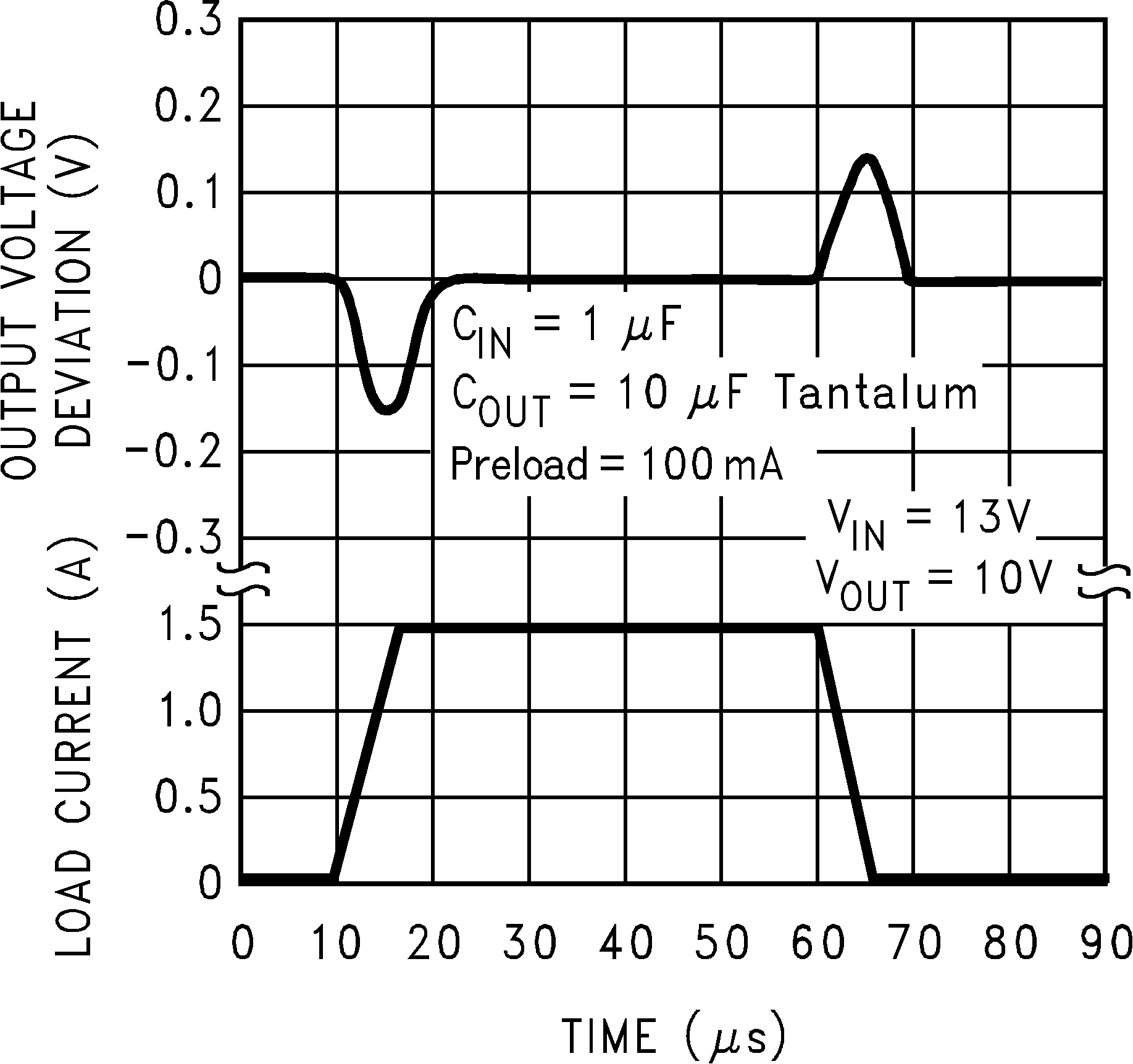JAJSDG4 June 2017 LM1086-MIL
PRODUCTION DATA.
- 1 特長
- 2 アプリケーション
- 3 概要
- 4 改訂履歴
- 5 Pin Configuration and Functions
- 6 Specifications
- 7 Detailed Description
-
8 Application and Implementation
- 8.1 Application Information
- 8.2 Typical Applications
- 8.3
Other Applications
- 8.3.1 Adjustable at 5 V
- 8.3.2 5-V Regulator with Shutdown
- 8.3.3 Battery Charger
- 8.3.4 Adjustable Fixed Regulator
- 8.3.5 Regulator With Reference
- 8.3.6 High-Current Lamp-Driver Protection
- 8.3.7 Battery-Backup-Regulated Supply
- 8.3.8 Ripple Rejection Enhancement
- 8.3.9 Automatic Light Control
- 8.3.10 Remote Sensing
- 9 Power Supply Recommendations
- 10Layout
- 11デバイスおよびドキュメントのサポート
- 12メカニカル、パッケージ、および注文情報
6 Specifications
6.1 Absolute Maximum Ratings
over operating free-air temperature range (unless otherwise noted) (1)(2)| MIN | MAX | UNIT | ||
|---|---|---|---|---|
| Maximum input-to-output voltage differential | LM1086-MIL-ADJ | 29 | V | |
| LM1086-MIL-1.8 | 27 | V | ||
| LM1086-MIL-2.5 | 27 | V | ||
| LM1086-MIL-3.3 | 27 | V | ||
| LM1086-MIL-5 | 25 | V | ||
| Power dissipation(3) | Internally Limited | |||
| Junction temperature (TJ)(4) | 150 | °C | ||
| Storage temperature, Tstg | –65 | 150 | °C | |
(1) Stresses beyond those listed under Absolute Maximum Ratings may cause permanent damage to the device. These are stress ratings only, which do not imply functional operation of the device at these or any other conditions beyond those indicated under Recommended Operating Conditions. Exposure to absolute-maximum-rated conditions for extended periods may affect device reliability.
(2) If Military/Aerospace specified devices are required, contact the Texas Instruments Sales Office/Distributors for availability and specifications.
(3) Power dissipation is kept in a safe range by current limiting circuitry. Refer to Overload Recovery in Application and Implementation. The value RθJA for the WSON package is specifically dependent on PCB trace area, trace material, and the number of thermal vias. For improved thermal resistance and power dissipation for the WSON package, refer to AN-1187 Leadless Leadframe Package (LLP)
(4) The maximum power dissipation is a function of TJ(MAX) , RθJA, and TA. The maximum allowable power dissipation at any ambient temperature is PD = (TJ(MAX) – T A) / RθJA. All numbers apply for packages soldered directly into a PC board. Refer to Thermal Considerations.
6.2 ESD Ratings
| VALUE | UNIT | |||
|---|---|---|---|---|
| V(ESD) | Electrostatic discharge | Human-body model (HBM), per ANSI/ESDA/JEDEC JS-001(1) | ±2000 | V |
(1) JEDEC document JEP155 states that 500-V HBM allows safe manufacturing with a standard ESD control process.
6.3 Recommended Operating Conditions
| MIN | MAX | UNIT | ||
|---|---|---|---|---|
| JUNCTION TEMPERATURE RANGE (TJ)(1) | ||||
| C grade | Control section | 0 | 125 | °C |
| Output section | 0 | 150 | °C | |
| I grade | Control section | −40 | 125 | °C |
| Output section | −40 | 150 | °C | |
(1) The maximum power dissipation is a function of TJ(MAX) , RθJA, and TA. The maximum allowable power dissipation at any ambient temperature is PD = (TJ(MAX) – T A) / RθJA. All numbers apply for packages soldered directly into a PC board. Refer to Thermal Considerations.
6.4 Thermal Information
| THERMAL METRIC(1) | LM1086-MIL | UNIT | |||
|---|---|---|---|---|---|
| KTT | NDE | NGN | |||
| 3 PINS | 3 PINS | 8 PINS | |||
| RθJA | Junction-to-ambient thermal resistance | 40.8 | 23.0 | 35.9 | °C/W |
| RθJC(top) | Junction-to-case (top) thermal resistance | 42.3 | 16.1 | 24.2 | °C/W |
| RθJB | Junction-to-board thermal resistance | 23.3 | 4.5 | 13.2 | °C/W |
| ψJT | Junction-to-top characterization parameter | 10.2 | 2.4 | 0.2 | °C/W |
| ψJB | Junction-to-board characterization parameter | 22.3 | 2.5 | 13.3 | °C/W |
| RθJC(bot) | Junction-to-case (bottom) thermal resistance: control section/output section | 1.5/4 | 1.5/4 | 2.9 | °C/W |
(1) For more information about traditional and new thermal metrics, see the Semiconductor and IC Package Thermal Metrics application report.
6.5 Electrical Characteristics
Typicals and limits appearing in normal type apply for TJ = 25°C unless specified otherwise.| PARAMETER | TEST CONDITIONS | TJ = 25°C | TJ over the entire range for operation (see Recommended Operating Conditions) | UNIT | |||||
|---|---|---|---|---|---|---|---|---|---|
| MIN | TYP | MAX | MIN(1) | TYP(2) | MAX (1) | ||||
| VREF | Reference voltage | LM1086-MIL-ADJ, IOUT = 10 mA, VIN − VOUT = 3 V, 10 mA ≤ IOUT ≤ IFULL LOAD, 1.5 V ≤ VIN − VOUT ≤ 15 V(3) | 1.238 | 1.25 | 1.262 | 1.225 | 1.250 | 1.27 | V |
| VOUT | Output voltage(3) | LM1086-MIL-1.8, IOUT = 0 mA, VIN = 5 V, 0 ≤ IOUT ≤ IFULL LOAD, 3.3 V ≤ VIN ≤ 18 V | 1.782 | 1.8 | 1.818 | 1.764 | 1.8 | 1.836 | V |
| LM1086-MIL-2.5, IOUT = 0 mA, VIN = 5 V, 0 ≤ IOUT ≤ IFULL LOAD, 4.0 V ≤ VIN ≤ 18 V | 2.475 | 2.5 | 2.525 | 2.450 | 2.5 | 2.55 | V | ||
| LM1086-MIL-3.3, IOUT = 0 mA, VIN = 5 V, 0 ≤ IOUT ≤ IFULL LOAD, 4.75 V ≤ VIN ≤ 18 V | 3.267 | 3.3 | 3.333 | 3.235 | 3.3 | 3.365 | V | ||
| LM1086-MIL-5, IOUT = 0 mA, VIN = 8 V, 0 ≤ IOUT ≤ IFULL LOAD, 6.5 V ≤ VIN ≤ 20 V | 4.950 | 5 | 5.05 | 4.9 | 5 | 5.1 | V | ||
| ΔVOUT | Line regulation(4) | LM1086-MIL-ADJ, IOUT =10 mA, 1.5 V ≤ (VIN - VOUT) ≤ 15 V | 0.015% | 0.2% | 0.035% | 0.2% | |||
| LM1086-MIL-1.8, IOUT = 0 mA, 3.3 V ≤ VIN ≤ 18 V | 0.3 | 6 | 0.6 | 6 | mV | ||||
| LM1086-MIL-2.5, IOUT = 0 mA, 4.0 V ≤ VIN ≤ 18 V | 0.3 | 6 | 0.6 | 6 | mV | ||||
| LM1086-MIL-3.3, IOUT = 0 mA, 4.5 V ≤ VIN ≤ 18 V | 0.5 | 10 | 1 | 10 | mV | ||||
| LM1086-MIL-5, IOUT = 0 mA, 6.5 V ≤ VIN ≤ 20 V | 0.5 | 10 | 1 | 10 | mV | ||||
| ΔVOUT | Load regulation(4) | LM1086-MIL-ADJ, (VIN-V OUT ) = 3 V, 10 mA ≤ IOUT ≤ IFULL LOAD | 0.1% | 0.3% | 0.2% | 0.4% | |||
| LM1086-MIL-1.8, 2.5, VIN = 5 V, 0 ≤ IOUT ≤ IFULL LOAD | 3 | 12 | 6 | 20 | mV | ||||
| LM1086-MIL-3.3, VIN = 5 V, 0 ≤ IOUT ≤ IFULL LOAD | 3 | 15 | 7 | 25 | mV | ||||
| LM1086-MIL-5, VIN = 8 V, 0 ≤ IOUT ≤ IFULL LOAD | 5 | 20 | 10 | 35 | mV | ||||
| Dropout voltage(5) | LM1086-MIL-ADJ, 1.8, 2.5, 3.3, 5, ΔVREF, ΔVOUT = 1%, IOUT = 1.5 A | 1.3 | 1.5 | V | |||||
| ILIMIT | Current limit | LM1086-MIL-ADJ, VIN − VOUT = 5 V, VIN − VOUT = 25 V | 1.5 | 2.7 | A | ||||
| 0.05 | 0.15 | ||||||||
| LM1086-MIL-1.8,2.5, 3.3, VIN = 8 V | 1.5 | 2.7 | A | ||||||
| LM1086-MIL-5, VIN = 10 V | 1.5 | 2.7 | A | ||||||
| Minimum load current(6) | LM1086-MIL-ADJ, VIN −VOUT = 25 V | 5 | 10 | mA | |||||
| Quiescent current | LM1086-MIL-1.8, 2.5, VIN ≤ 18 V | 5 | 10 | mA | |||||
| LM1086-MIL-3.3, VIN ≤ 18 V | 5 | 10 | mA | ||||||
| LM1086-MIL-5, VIN ≤ 20 V | 5 | 10 | mA | ||||||
| Thermal regulation | TA = 25°C, 30-ms pulse | 0.008 | 0.04 | %/W | |||||
| Ripple rejection | fRIPPLE = 120 Hz, COUT = 25 µF Tantalum, IOUT = 1.5 A | 60 | 75 | dB | |||||
| LM1086-MIL-ADJ, CADJ = 25 µF, (VIN− VO) = 3 V | |||||||||
| LM1086-MIL-1.8, 2.5, VIN = 6 V | 60 | 72 | dB | ||||||
| LM1086-MIL-3.3, VIN= 6.3 V | 60 | 72 | dB | ||||||
| LM1086-MIL-5 VIN = 8 V | 60 | 68 | dB | ||||||
| Adjust pin current | LM1086-MIL | 55 | 120 | µA | |||||
| Adjust pin current change | 10 mA ≤ IOUT ≤ IFULL LOAD, 1.5 V ≤ (VIN − VOUT) ≤ 15 V | 0.2 | 5 | µA | |||||
| Temperature stability | 0.5% | ||||||||
| Long-term stability | TA = 125°C, 1000 Hrs | 0.3% | 1% | ||||||
| RMS Noise (% of VOUT) |
10 Hz ≤ f≤ 10 kHz | 0.003% | |||||||
(1) All limits are specified by testing or statistical analysis.
(2) Typical values represent the most likely parametric norm.
(3) IFULL LOAD is defined in the current limit curves. The IFULL LOAD Curve defines current limit as a function of input-to-output voltage. Note that 15 W power dissipation for the LM1086-MIL is only achievable over a limited range of input-to-output voltage.
(4) Load and line regulation are measured at constant junction temperature, and are specified up to the maximum power dissipation of 15 W. Power dissipation is determined by the input/output differential and the output current. Ensured maximum power dissipation will not be available over the full input/output range.
(5) Dropout voltage is specified over the full output current range of the device.
(6) The minimum output current required to maintain regulation.
6.6 Typical Characteristics
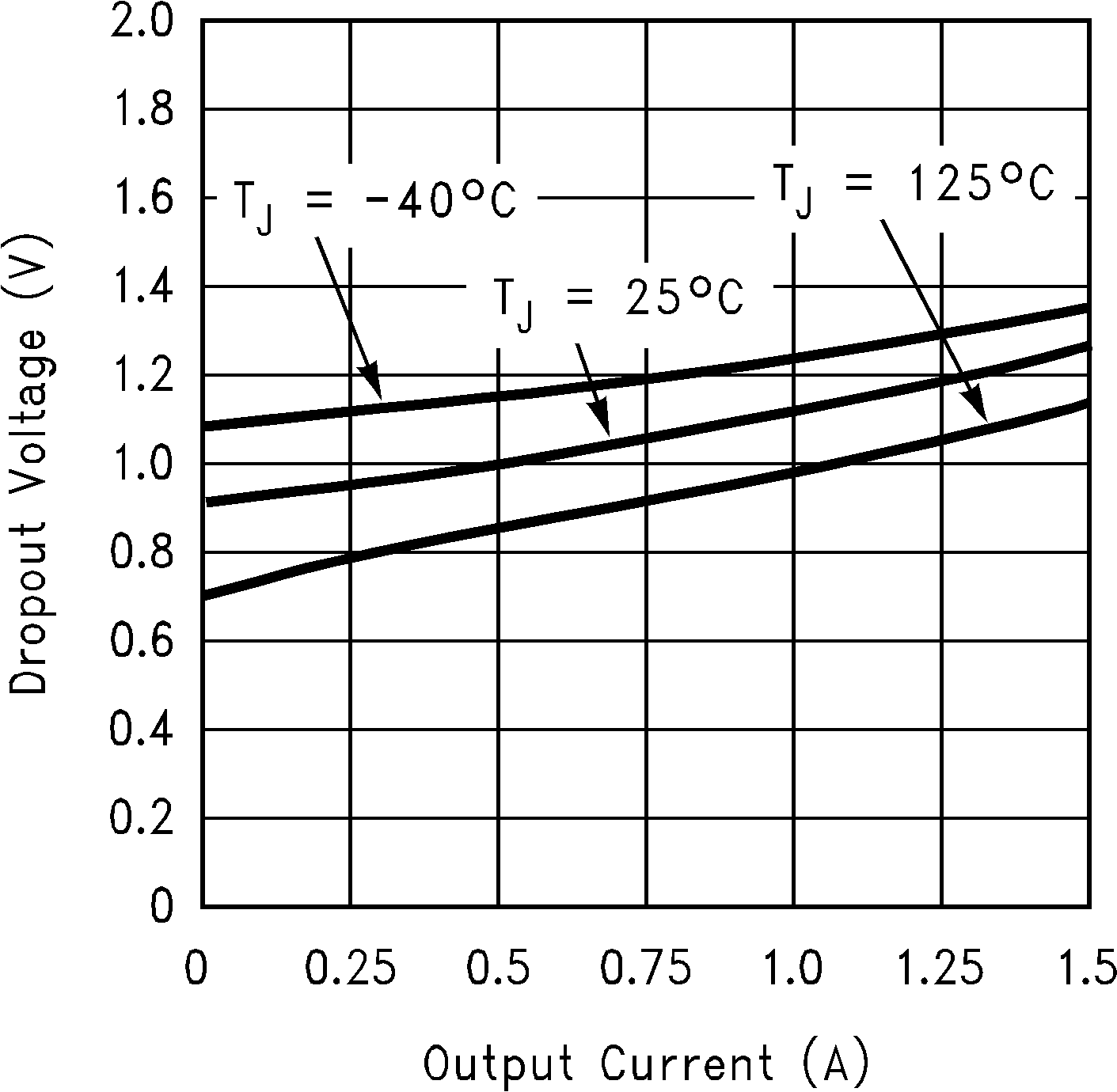
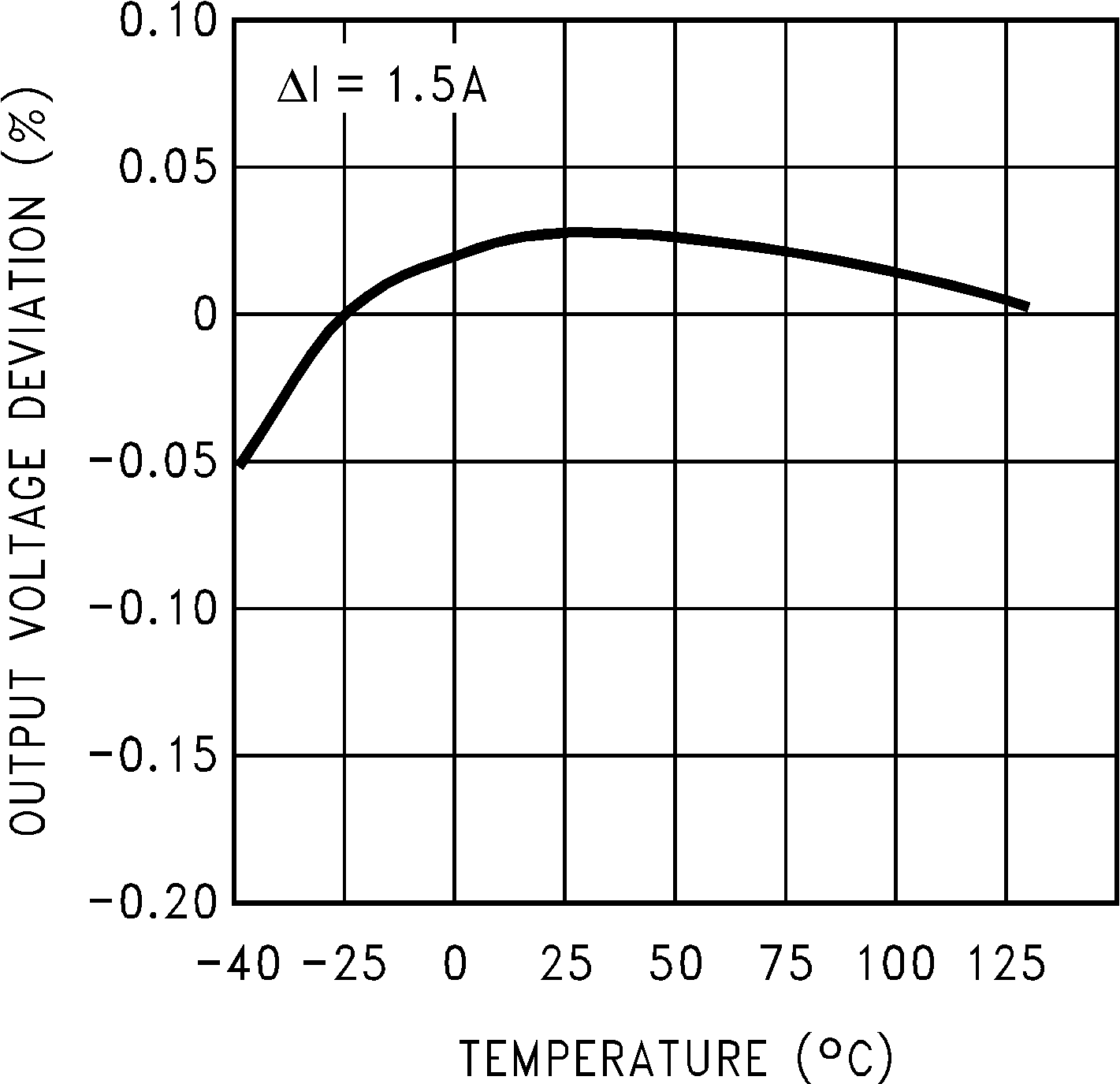
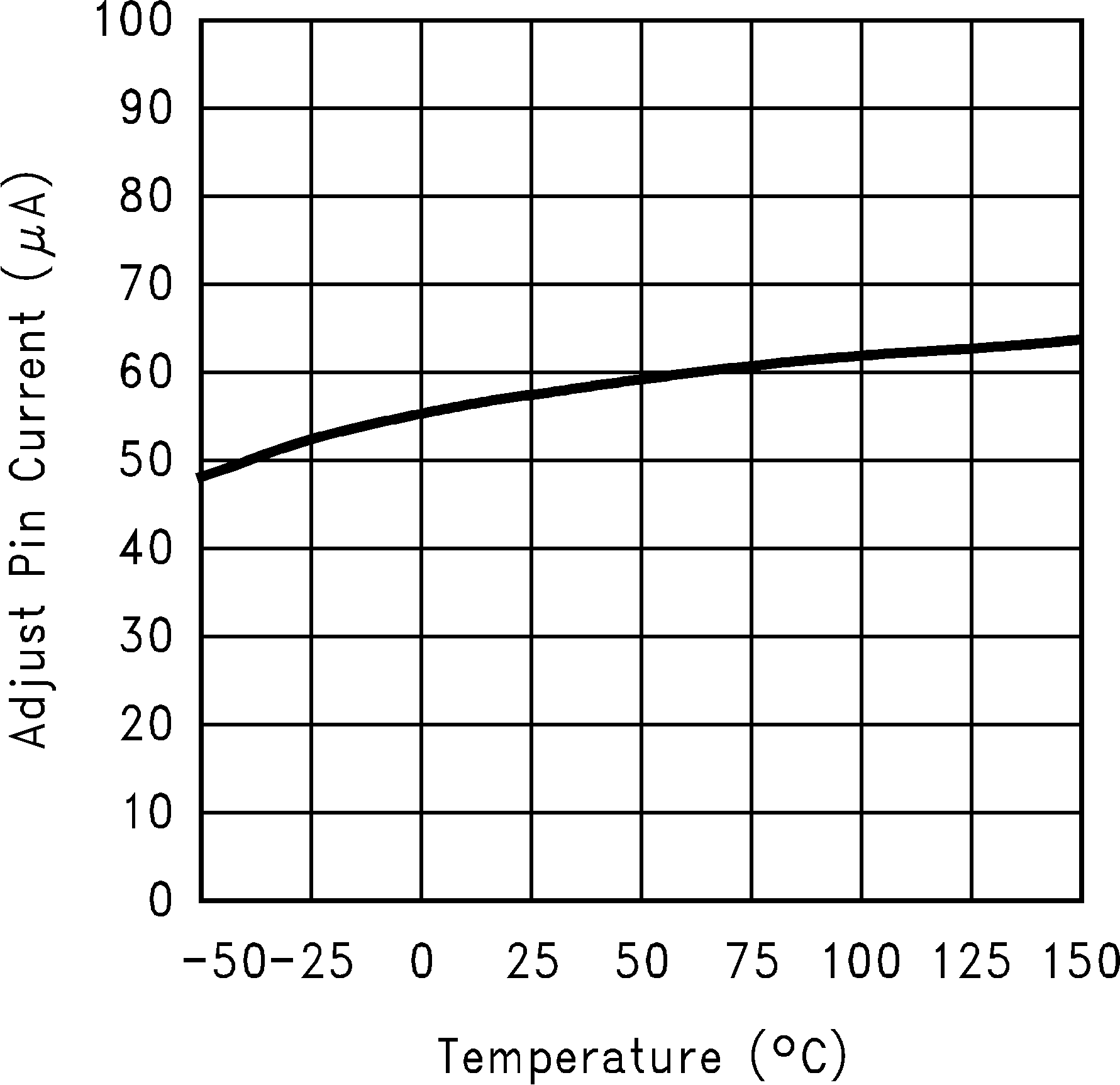
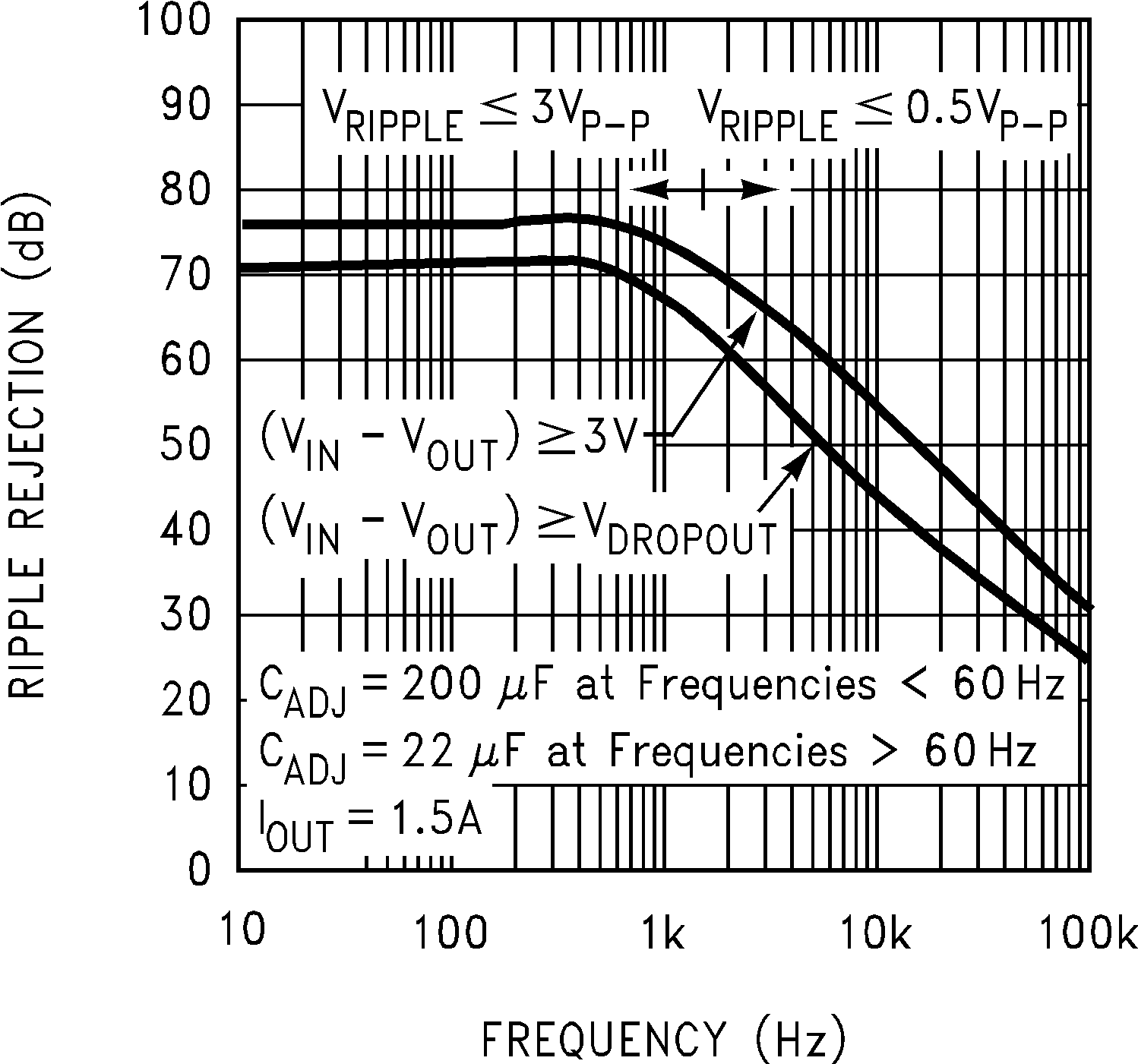
(LM1086-MIL-ADJ)
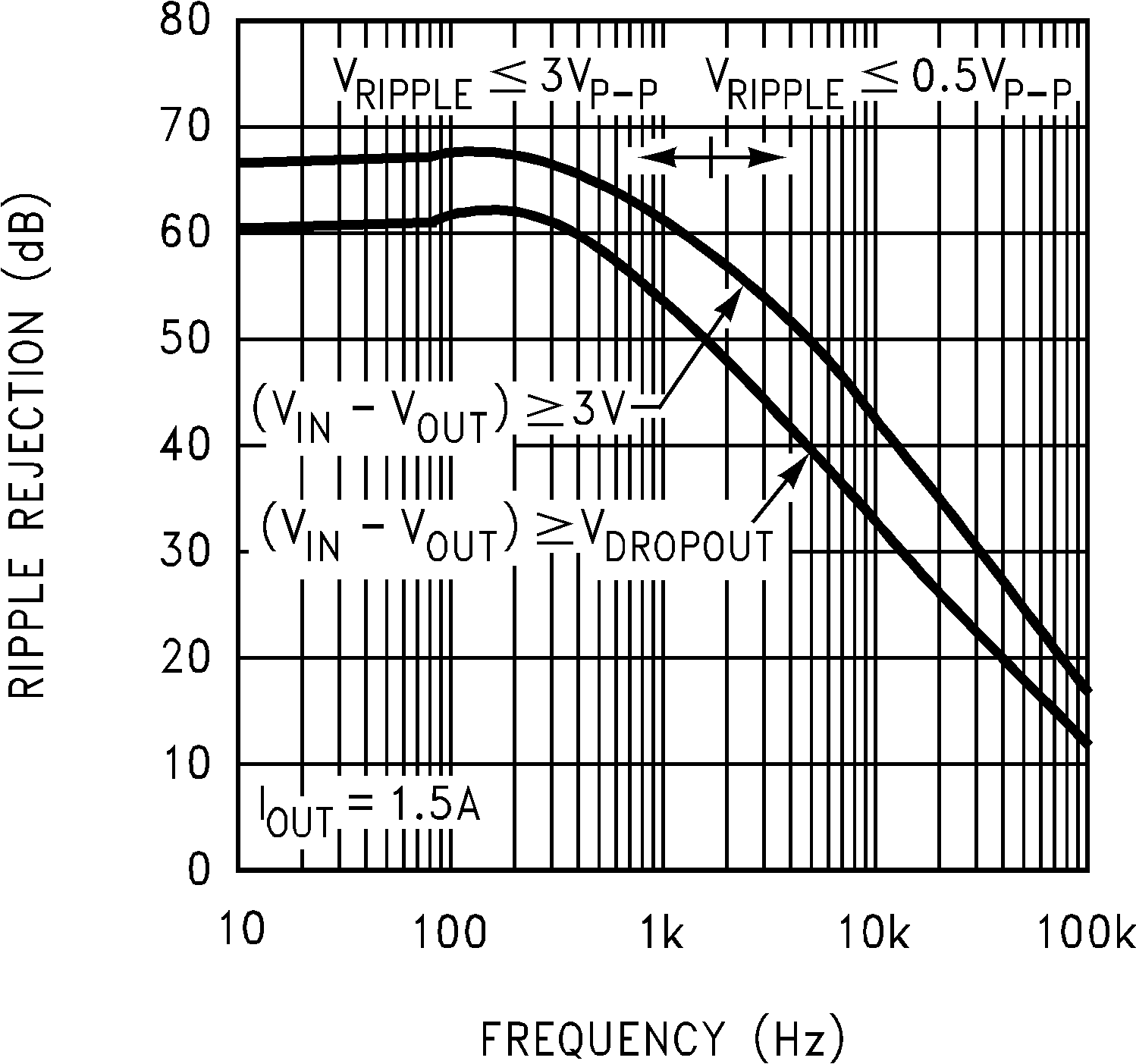
(LM1086-MIL-5)
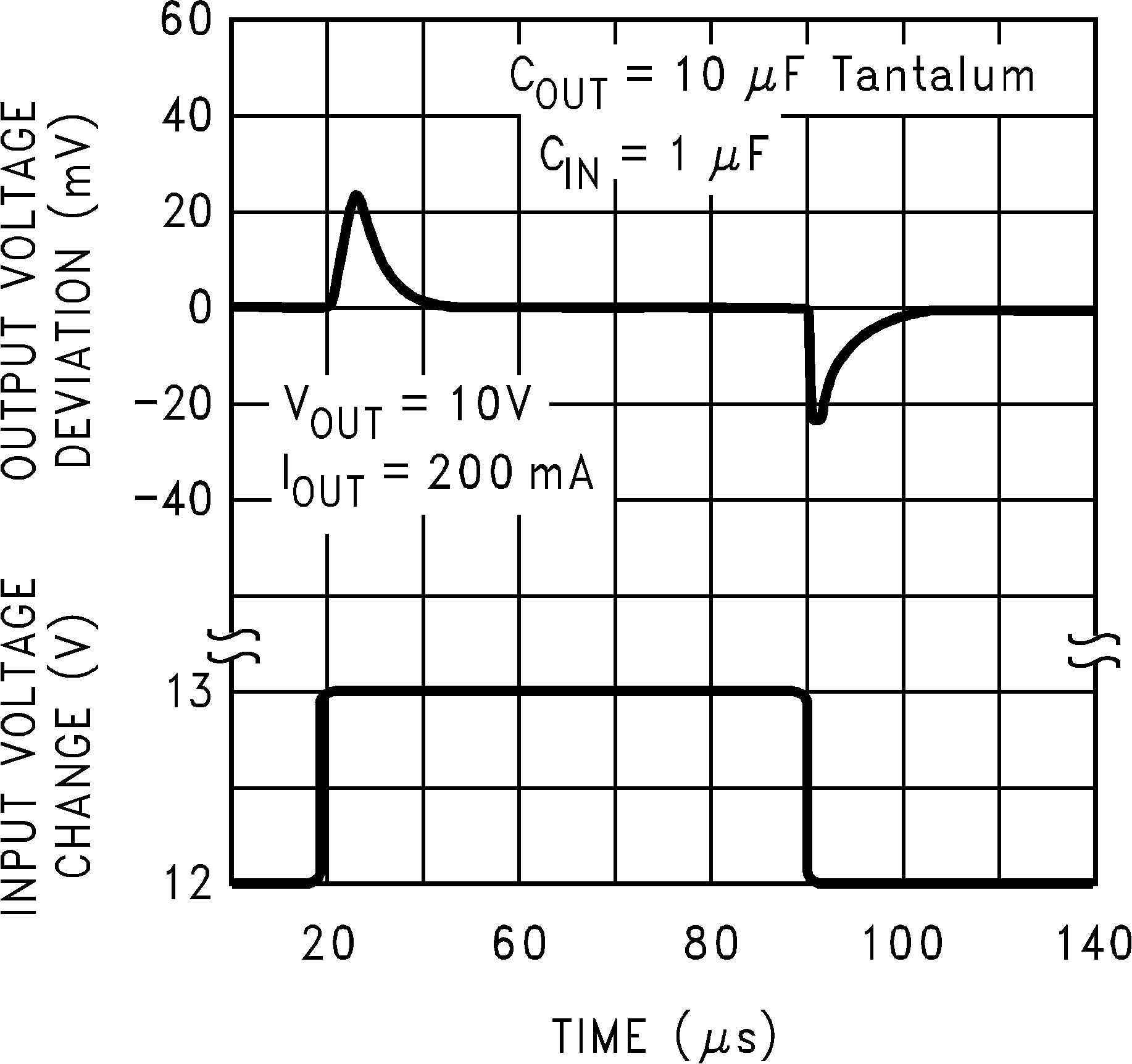
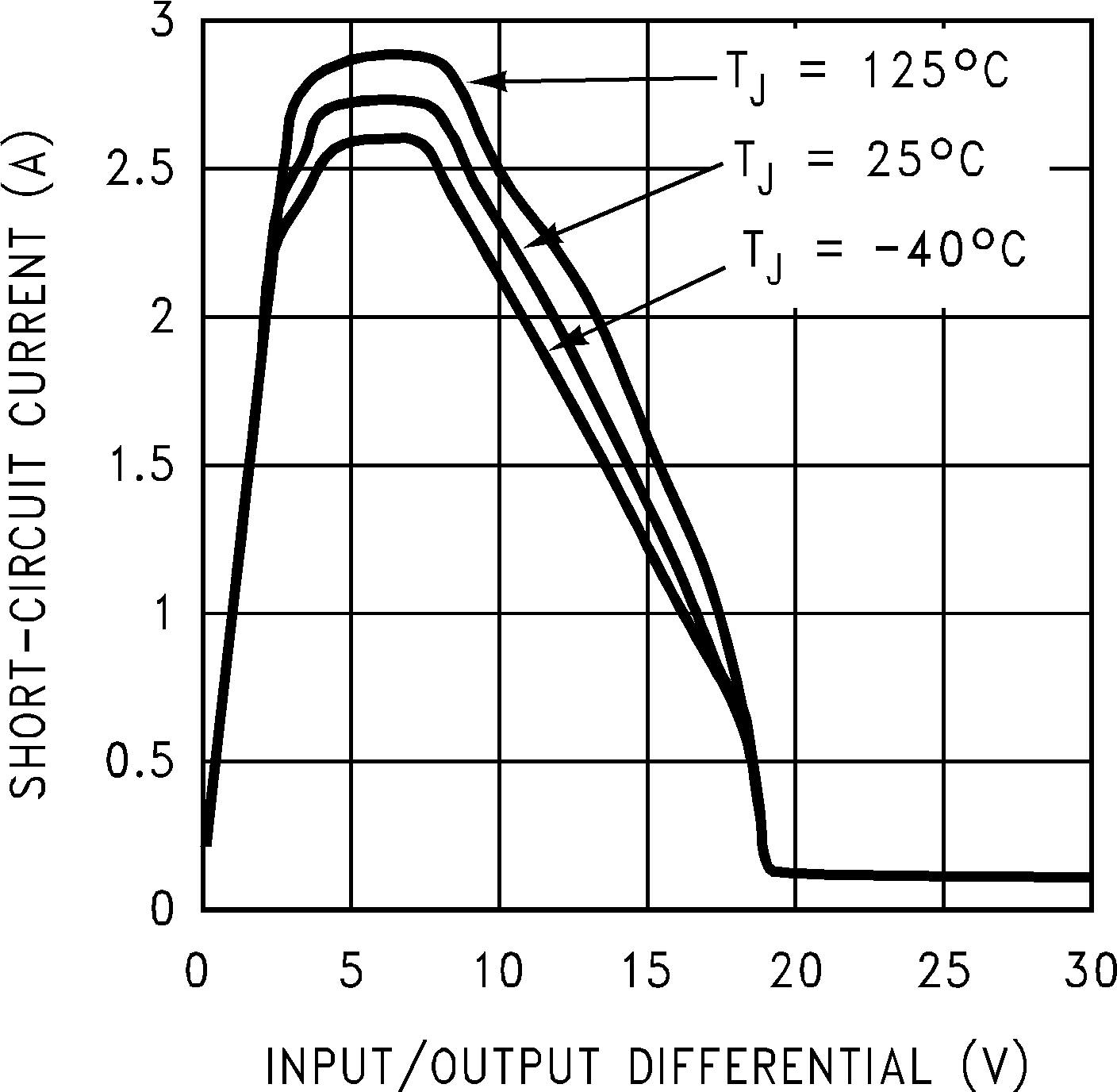
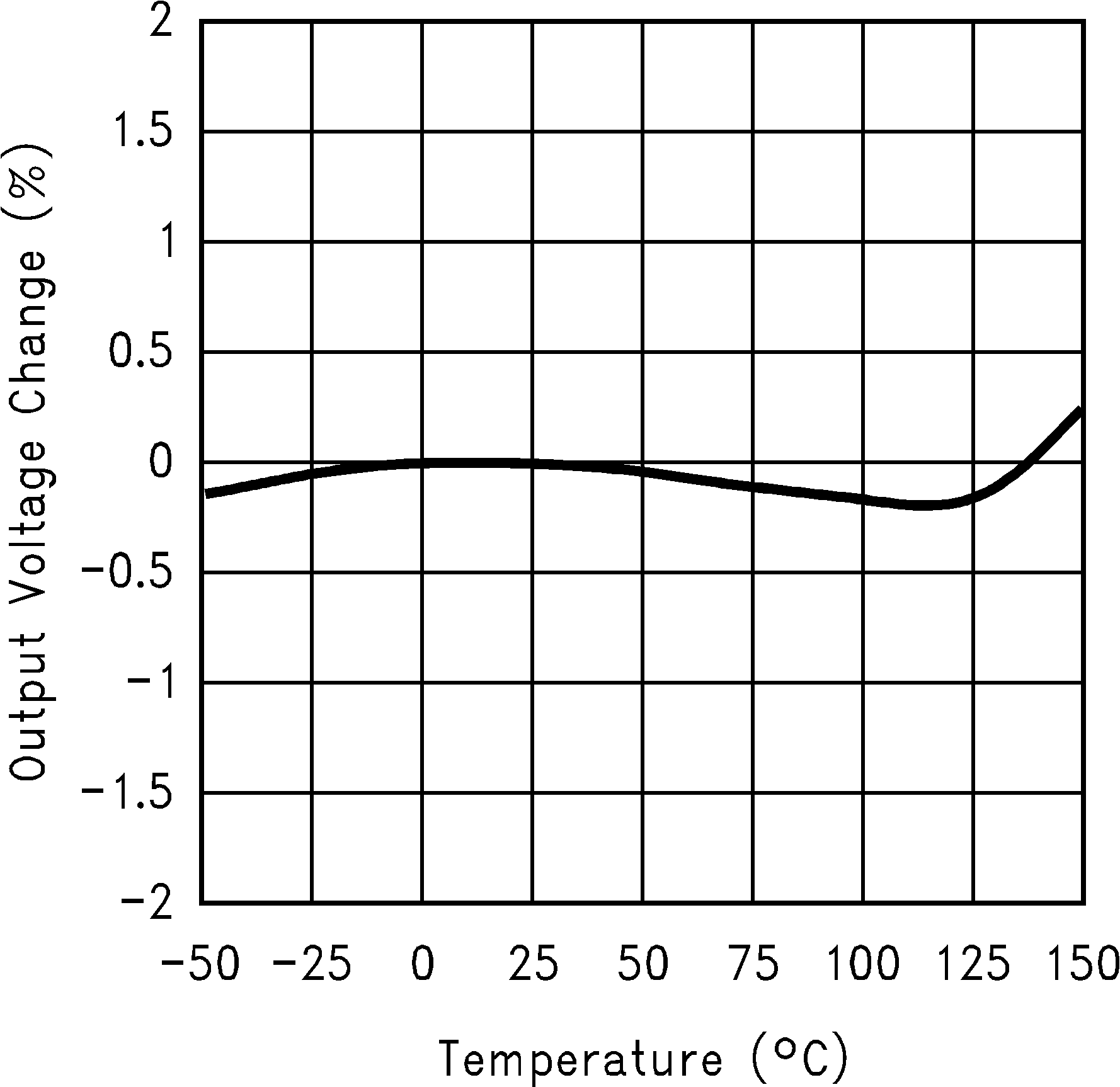
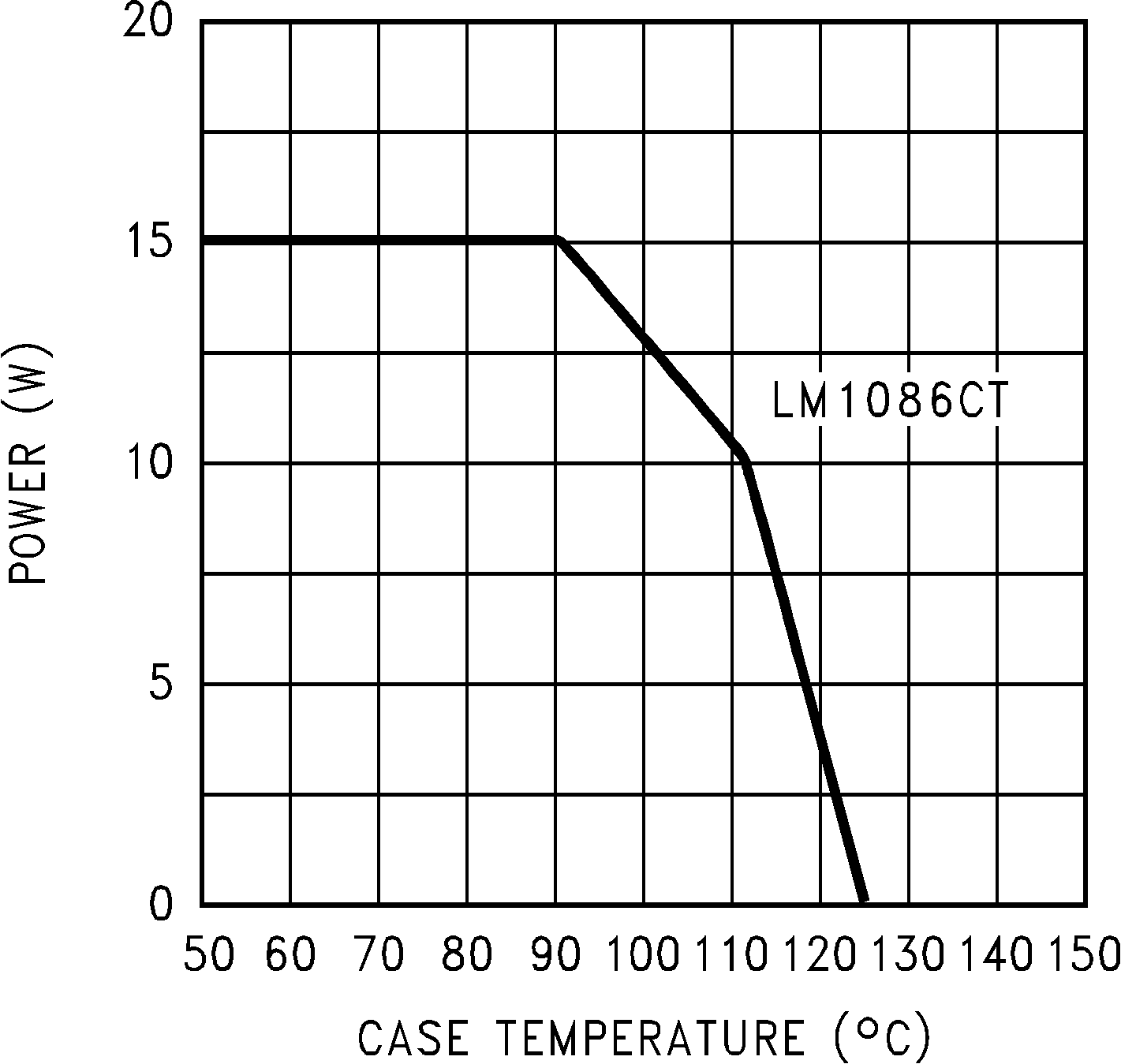
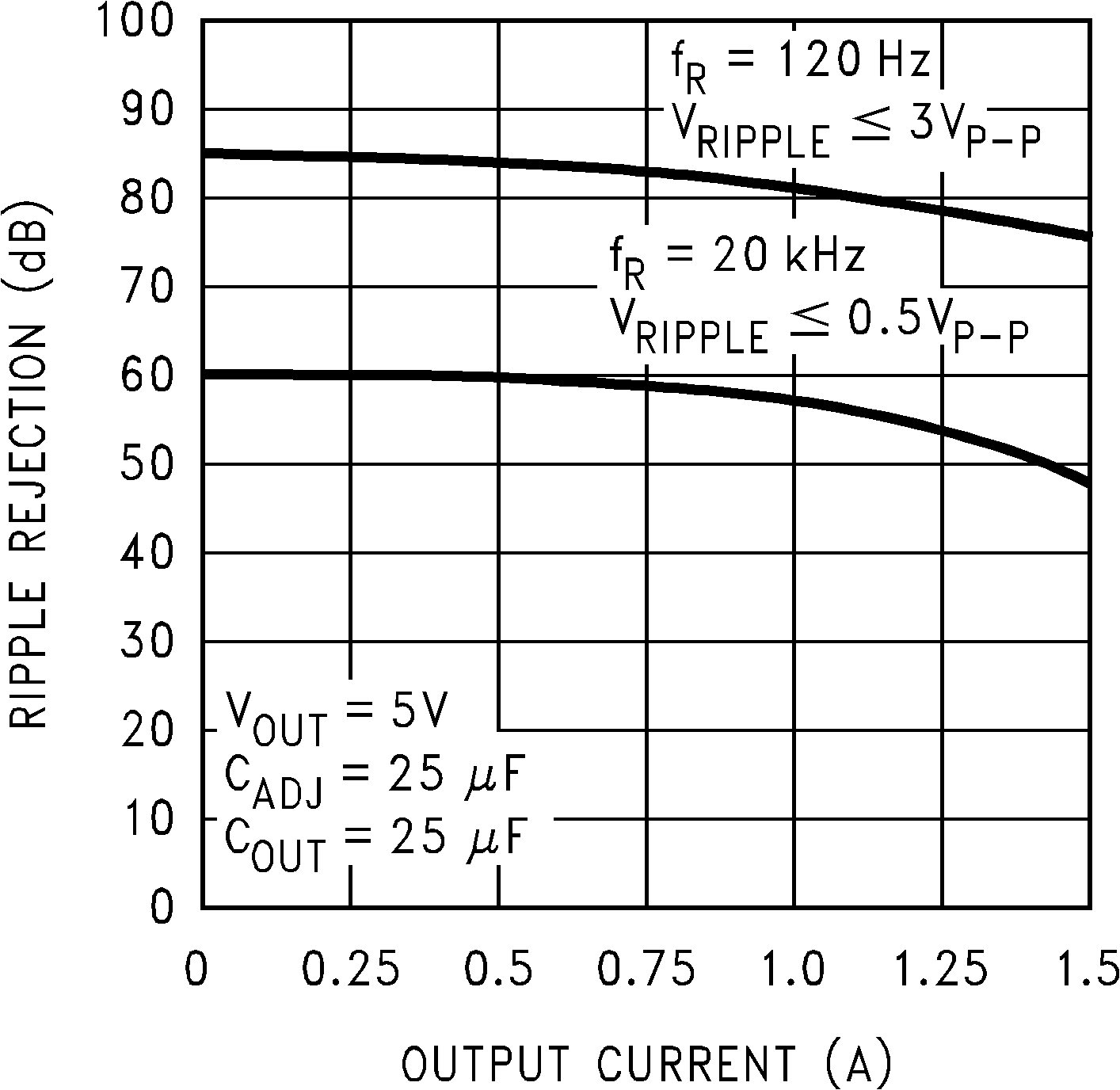
(LM1086-MIL-ADJ)
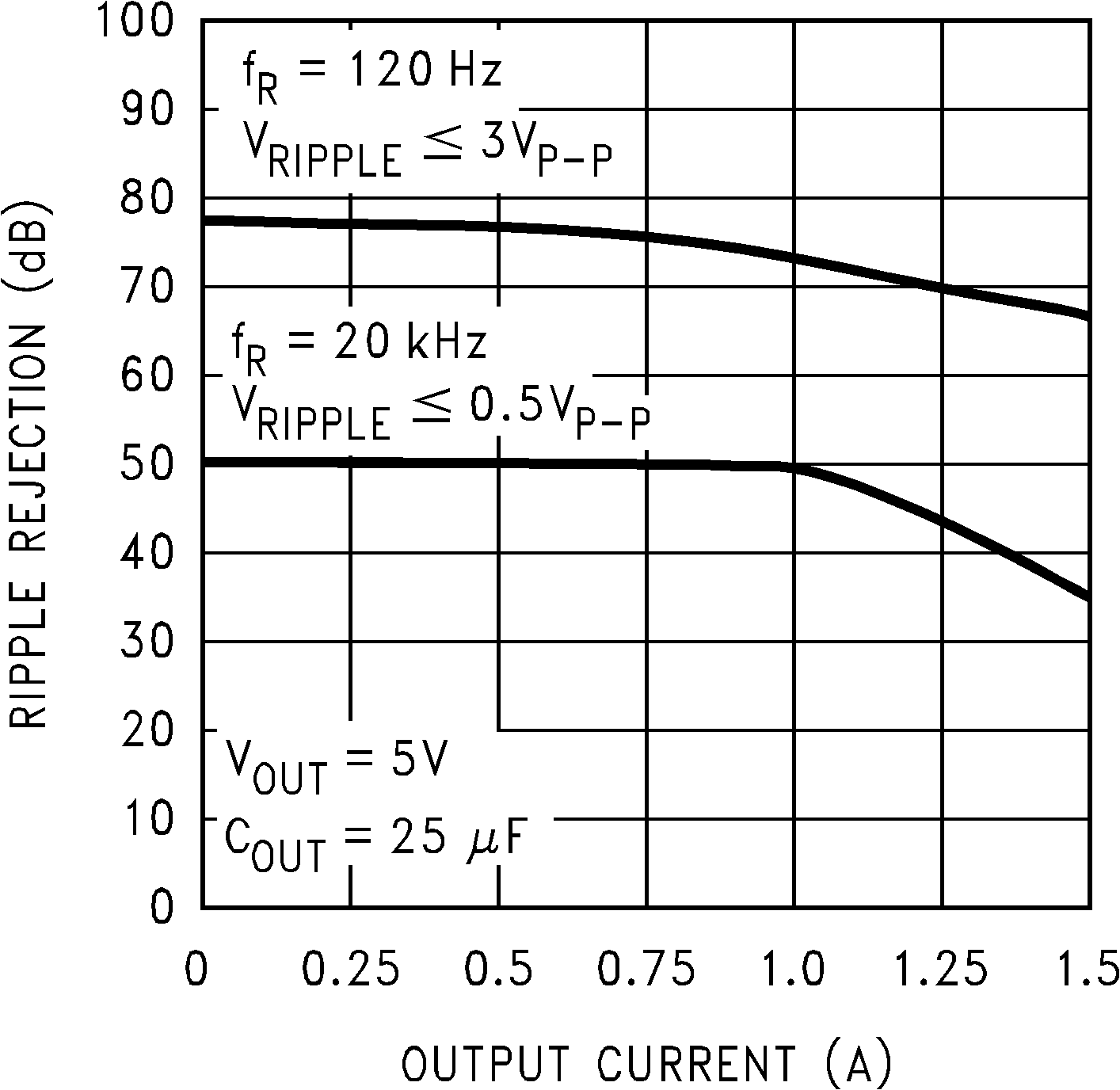
(LM1086-MIL-5)
